
Ifriqiya, a cultural and commercial center in Northern Africa
The great strategic importance of the city of Carthage made it an impregnable stronghold for the Arab armies in their attempt to penetrate the North of Africa. Hence, it was Kairouan that was the city founded as the capital of Ifriqiya. Therefore, Qayrawan was the city founded as the capital of Ifriqiya.
When the first Arab contingents entered the region of Tunisia (Ifriqiya), they immediately understood that Carthage, the capital city of the zone in ancient times, was the point of major resistance before their advance over northern Africa. The Arab fleet had not at the time the size it reached later on, when it was to lord over the whole Mediterranean area. And Carthage, on land, was the most impregnable stronghold in the second half of the seventh century. The truth is that the rise of Musa b. Nusayr (Sidi Uqba) was ultimately due to his defeat of the Carthaginian resistance in the 690’s. The foundation of Kairouan by Sidi Uqba, two decades earlier at a certain distance from the Mediterranean shores and the ancient Carthaginian capital, although sheltered from both of them, was a consequence of a clever flanking manoeuvre through the centre of the country that avoided a frontal attack by the Byzantines who were along the coast. Sidi Uqba’s decision left in any case a profound mark in the history of Tunisia and the whole of western Islam. The Arab presence meant a bigger territorial occupation than that of former settlers, such as Phoenicians, Carthaginians, Romans or Byzantines. This expansion stretched towards black Africa and the Far West, all the way to Tingitania and the Iberian Peninsula. From Kairouan they reached Tangiers, the Senegal basin, the middle reaches of the Niger river, or western Sudan ̶ as it was known at the time ̶ up to Poitiers (France). This is ultimately the profound historical legacy of the future capital of the Aghlabids.
From the newly founded city of Kairouan, the Umayyad governor of Ifriqiya (northern Africa) Hasan Ibn al-Nunam, who was appointed by the caliph of Damascus, conquered Carthage in the year 692. Two years later, the stronghold returned again to Byzantine hands, who understood that the loss of the Gulf of Tunisia entailed the end of their control over the area. The western Roman Empire lost one of the strongholds which sustained the power it had over the west of the ancient Mare Nostrum. In 698, Musa b. Nusayr, commanding a fleet which had started to take shape with the first expansion in the eastern Mediterranean, defeated the Byzantine navy opposite Carthage. The city came into Arab hands, hence proving the efficacy of the tactical move started by Sidi Uqba. From there, Musa, already being the governor of Ifriqiya, would reach the lands of Al-Andalus, the ancient Hispania, beginning in the year 711.
The spirit of Kairouan starts to take shape in these early years after its incorporation into the Umayyad Empire. The city is one of the most important centres in North Africa, the necessary link towards the West in the direction of the lands of Europe, but also to the continent of Africa.
Turned into a political centre, the city will remain as a cultural and commercial enclave for the rest of its history until today. The city represented, when the second expansion of the empire took place, and when it was founded by Sidi Uqba, the link between the Arabian Peninsula and the lands that they were adding to their domains, both in the African continent and beyond the straits of Gibraltar and Messina. Between the 8th and 15th centuries, the legacy of Kairouan continued to expand towards the whole western Islam.
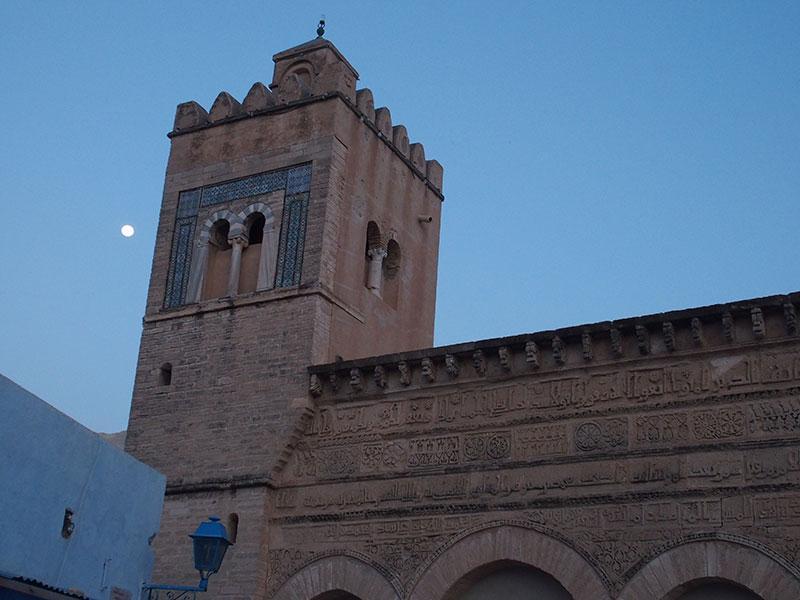
The extension of the Arab empire in the 8th century to the Iberian Peninsula was accomplished from origins in the Tunisian capital. The orders of the North Africa governor, Musa b. Nusayr, departed from there for the conquest of ancient Hispania. He himself was directly involved in the event later. Uqba b. Nafí’s descendants, known as the Fihris, participated in the settlement of the new territories together with Yemeni elements that pursued a predominant position from the first moments of Al-Andalus.
The story of the country over the first century responded to a script whose main actors fluctuated between the orders that the caliph of Damascus transmitted through the governors of Kairouan, the autonomous actions of them, the military elements that took part in the conquest, and the natives of Hispania who established alliances with the families of one or another of the commanders. For this reason, the influence of Kairouan, mainly until the arrival in 755 of the emir Abd-er-Rahman I, which brought a new dynamic to the Iberian Peninsula, was decisive for establishing the bases of the regime of Al- Andalusian. In later centuries the Andalusia-Tunisia bridges endured unbroken beyond the momentary political vicissitudes.
When Idris I arrived at the end of the 8th century in the lands of the Far Maghreb, he found a political and administrative environment which resulted directly from the conditions of the Arab conquest and the fragmentation that the territory already had in previous times. The Roman and Byzantine settlements had been almost entirely restricted to the coastal areas. This is why the founder of the Idrisid dynasty resorted to a logical mechanism that bore in mind the situation of the whole region of the Arab West. The necessity of constituting a capital that would allow a viable administration over their domains can be found in the roots of the foundation of Fes, one of the cities that would articulate the North African space in the future. In this way, the city took in two contingents of immigrants, which configured its initial neighbourhoods: those who came from Kairouan and those from Al-Andalus who were forced to leave the country by decision of the Umayyad caliph as the consequence of having led the revolts in the Arrabal (quarter) of Segunda in Córdoba. The fact of counting on contingents from Kairouan emphasizes the pivotal role that the city played at that moment in the entire region. In this sense it acted, as in former occasions, as a mother-city. This was also what the city did later on, to a lesser extent, in the African continent. In later times, the Aghlabids took Kairouan to its first period of splendour. Its establishment, in the early 9th century, was a consequence of the Arab Empire’s fragmentation, brought about by an Abbasid general, Ibrahim Ibn Aghlab, who little by little was regaining autonomy from the caliphs of Bagdad. This fragmentation, and the Aghlabids, are outstanding examples because not only it was not traumatic, but also it made feasible a social, political and economic structure in the Arab world in the Middle Ages and gave rise to a considerable upturn in the area. In this way, Ibrahim Ibn Aghlab’s successors, already a dynasty, achieved a better use of the land by means of irrigation, experimenting with new crops and even reforestation. They also proceeded to undertake a series of mining operations in lands that Romans had not exploited. As a family of rulers, they brought in outside talent, resulting in the foundation of a tiraz to produce luxury textiles, and their private minting of their own coins. It was their achievement that mad Kairouan an essential commercial centre for the whole of North Africa.
The impact in urban development was enormous at all levels. But also at the time of opening new routes towards the heart of Africa, in search of goods for trade and the gold of Sudan, it became essential for commerce to mint more and more coins, given the volume of goods that were moving.
Until the arrival of emir Abd-er-Rahman I in 755, Kairouan was decisive for establishing the basis of the al-Andalus regime.
The extension of the Arab Empire beyond the Sicilian Channel turned out to be a much more wide-ranged process than that of the Iberian Peninsula, one that came about in almost a vertiginous way. It took place a century after the troops of Tarik b. Ziyad crossed the Strait of Gibraltar. The Sicilian island was at those times under the sovereignty of the Byzantines. It was almost the last redoubt of the eastern Roman Empire in western Mediterranean. The Arab conquest of Sicily counted on the collaboration of elements from al-Andalus, but it was mainly due to the endeavour of the Aghlabids from Kairouan. The enterprise was to last until the middle of the 8th century. For all the Arab World this meant control of the Mediterranean. Perhaps with a greater intensity than that of the conquest of Crete. In the same way, the Aghlabids will remain the lords of Malta.
Arab Sicily will allow the access to the southern region of peninsular Italy, which, however, does not belong to the Arab Empire. The Sicilian space will do until the Norman conquest in the 11th century. The “Banu Aghlab” from Kairouan will be the administrators of this fundamental enclave for Mediterranean commerce until 909, when the Fatimids appear.
In the year 831 Palermo remains as the capital of the new Aghlabid province, receiving the Kairouani influence from its founding. The continuation of habits from Byzantine times show the mechanism of assimilation that medieval Islam adopted as a customary behaviour, allowing the integration of groups in a non-traumatic way, as it happened in many other places. From Palermo the attacks on lands beyond the Messina Strait was planned, without achieving results of territorial expansion. The Empire had stretched in this part of Europe up to Aghlabid Sicily.
However, the successors of Ibrahim b. Aghlab did make possible Kairouan’s influence towards the African Sahel. Before the arrival of the Arabs, the Mediterranean shore and eastern Sub-Saharan Africa were two separate human realms. The connection will be made through a series of routes interconnecting the East, via Siyilmasa, Awdagust and the cities of the rivers Senegal and Niger. In the central part will be also roads departing from Kairouan headed towards the centre of the Sahara, known historically as Eastern Sudan.
These roads were travelled by the caravans which transported to the ridges of the tropical forests of the Gulf of Guinea all the goods from the Mediterranean strip like salt, fabrics or pottery and luxury items. In the opposite direction came the gold that the Arab World needed for minting coins, given the great amounts of transactions that were taking place; exotic goods and other merchandises from Black Africa were also marketed. And in both directions was the transfer of slaves.
By means of these commercial exchanges, the arrival of Islam to eastern Sub-Saharan Africa was taking place gradually. The process lasts at least until the 14th century. There were some involvements in the opposite direction, from south to north, of populations from southern Sahel, which took part in the policies of the Mediterranean area, as was the case of the Almoravids, from the shores of the Senegal river, during the 11th century. The mullahs of Fes and Kairouan also participated in configuring Islam in this portion of Africa. But also, local uses and customs that today belong to the common culture of all Muslims were added. The interweaving in the story of the Curve of the Niger of kairaouani groups and moriscos from al-Andalus shows the changeability of a civilization which was born in this part of our history.
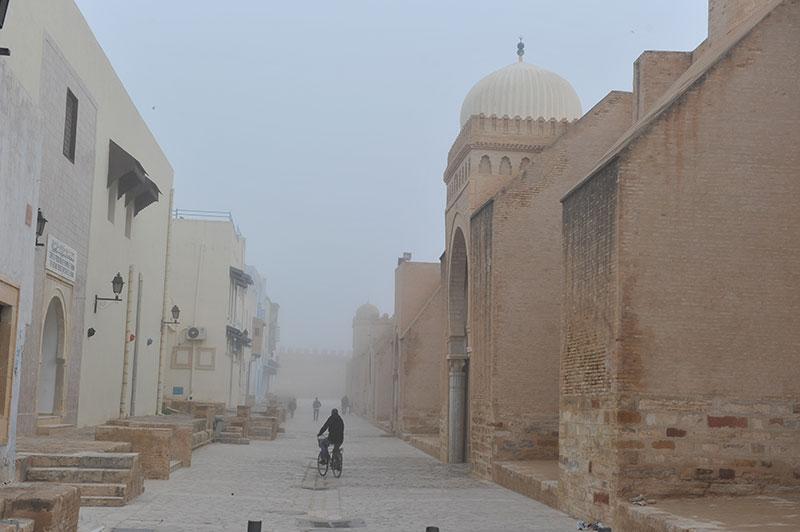
Yet, the spirit of Kairouan is also projected during the High Middle Ages, not only from standpoint of geographic expansion. Its influence goes beyond the extension of Muslim rule and the Arab culture towards East. The civilization which illuminated the Islam of the Middle Ages, the successor of the Mediterranean Greco-Latin heritage, was born thanks to the contributions of diverse groups and geographic regions. This gave as a result a common culture which was developed in a space of intense scientific, intellectual and economic relationships. The influence of Kairouan can be seen in the many and diverse parameters upon which this civilization lies. This fact is proved in its first period of splendour, up to the 10th century, when its action is most relevant, although it will also spread in later times.
One of these vectors can be seen in the paradigmatic mosque that rises from the one first built by Sidi Uqba. Its first construction takes place in the early times of Islamic settlement. The mosque will be, in addition to the market and the community’s headquarters of political and administrative power, one of the hallmarks of medieval Arab cities. In this case, departing from a first conception as a fortress, the oratory will be opened to other uses, as community mosques (aljamas) are doing at that time. The elements configured by Uqba are taken as examples to be considered in the Umayyad Aljama mosque of Córdoba and the Qarawiyyine of Fes. The sober minaret, which acts also as lookout tower, the wide courtyard which leads to the forest of columns in the prayer hall, and the system to collect water, are fixed as fundamental elements. Later on, we will see them in other places of prayer in the East.
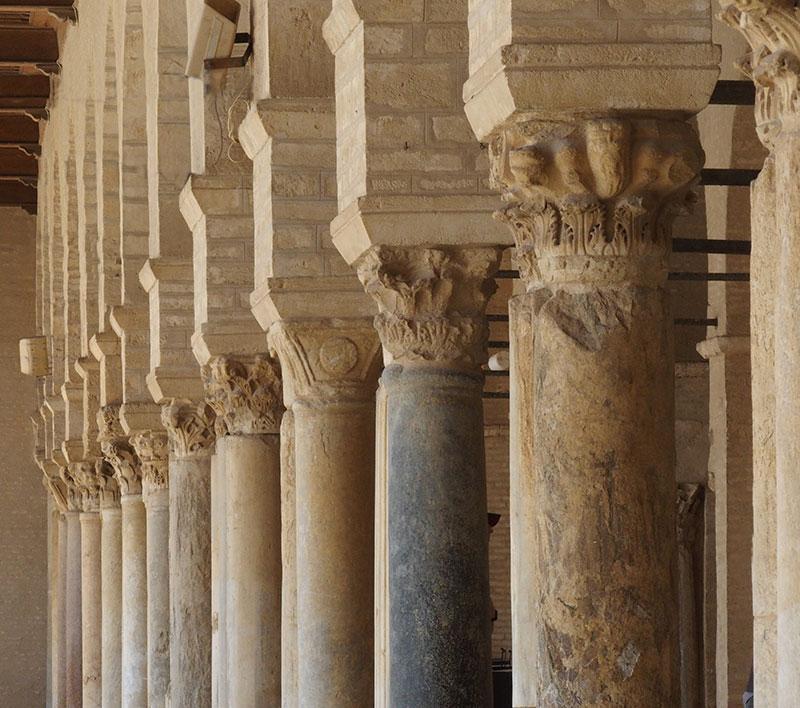
These galleries witnessed outstanding intellectual activity from their first moments. From them, mentors and ideas came out towards other places in the West. There is a legend that refers back to this sense, a wish expressed by the very Sidi Uqba at the time of its foundation: “My God, fill this city with science!”. Thus, a good number of medieval learned men stopped in the city on their ways to the East, building upon the wisdom of their masters to complete what they called the journey in search of knowledge. To encompass the functions that an Arab city must offer, Kairouan was also an important commercial centre. The effects of this economic boost on the whole area of northern Africa that entailed the Arab conquest, is reflected in the references from the beginning. On the one hand, its medina hosted craft activities like the manufacture of tapestries, valued all over the known world, which remains a renowned activity in our time. On the other, in their markets were exchanged not only the local products, but also those which came from the Atlantic shores and from as far away as China through the Silk Roads, and from the deepest regions of Africa, transported by the caravans that crossed the Sahara from the basins of Senegal and Niger rivers.
According to an old local legend, Ibn Uqba b. Nafi chose the location of Kairouan because, when his horse stumbled, a spring emerged whose waters came directly from the Well of Zamzam, located in the sacred enclosure of Mecca, where Abraham gave drink to Hagar after their crossing of the desert. In their origins, Arab peoples are rooted in commerce and in the steppes of the East. However, after being established in the Mediterranean, Morocco, Sicily and Algeria, agriculture flourished in a way that has remained inextricably linked to Western Islam. This is the reason why when we refer to the Arab World civilization, we do not refer to the Bedouins of the desert, but to sedentary populations, which merge with the reminiscences of the agriculture of South Arabia, or that which was practised in ancient Mesopotamia, as well as with Roman cultural knowledge.
The landscape of those times in the past can speak to us of a fertility greater than the one to which we are accustomed. This allowed a great agricultural performance, and also a scientific contribution in this field that perhaps finds its most important milestone in irrigation, or in the use of marginal soils. The Western Mediterranean fields, from Meknes to Jaén, show over the Middle Ages several examples. In the case of Kairouan, we have outstanding elements such as the Aghlabids reservoirs.
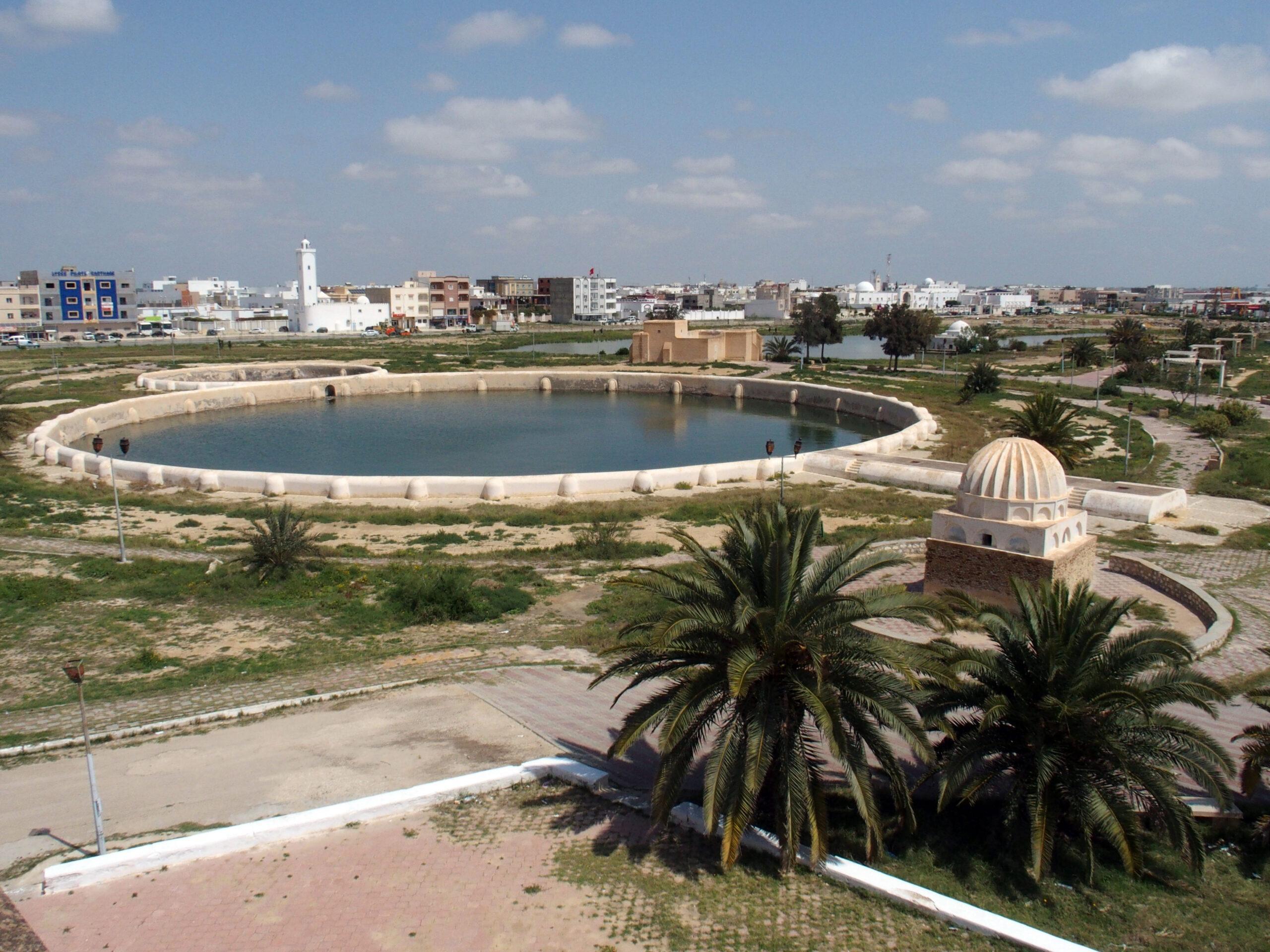
A reservoir, the great hydraulic work of the Aghlabids. Today, we have only a couple of them, but they could have been up to fourteen. This gives us an idea of the scale of effort that was undertaken in this field by the rulers of the city from the 8th century on. Besides of collecting rainwater, the system consisted of a procedure to bring in water from Mount Cherichera, around forty kilometres distant from the city.
Like other places in the region, water was the inspiration for a series of legends. Perhaps one of the most popular is that of Ahmad, the pilgrim of Kairouan who moved to Mecca to fulfil his Muslim precept of Hajj. As he was going to drink from the well of Zamzam, he lost his glass by carelessness. Later on, when he returned to the city, he found it in the same place where Sidi Uqba’s horse had given rise to the spring that originated the establishment of the capital.
Over the centuries, Kairouan became a place of welcoming for people from all around the known world. Important figures who have reached its walls throughout its history are countless. Some of them were particularly relevant. These include the Cordoban Muhammad b. Khayrun al- Maafiri, who arrived in the year 866 and built one of the jewels of the city, the so-called Mosque of the Three Doors. Or Ibn Sahnun (777-828), author of the Mudawwana and disciple of Malik b. Anas. The accounts of the Sevillian master Abu Bakr Muhammad az-Zubaydi (928-989) note up to fifty-seven of Ibn Sahnun’s Al-Andalus disciples who disseminated his teachings in the Iberian PeninsulaAl-Zubaydi himself highlights the task of Ibn Sahnun as a philologist in his work Grammarians and linguists categories.
At this moment, when the history of Humanity should offer meeting points to address the future ensuring viability, a fact like this one might add value to the meaning of this city.
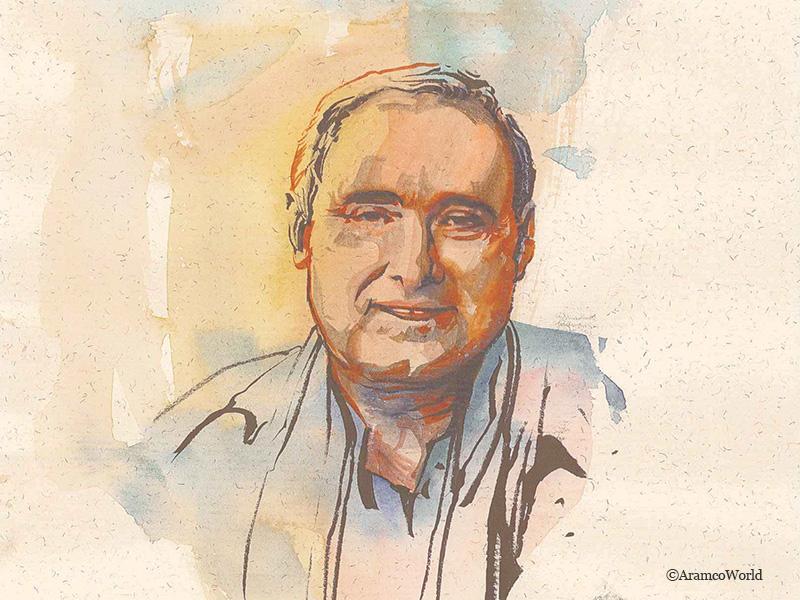
Portrait of Rafael Valencia by Jesús Conde


